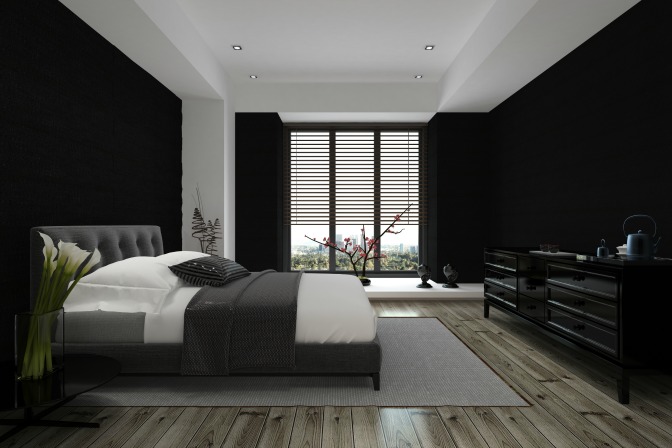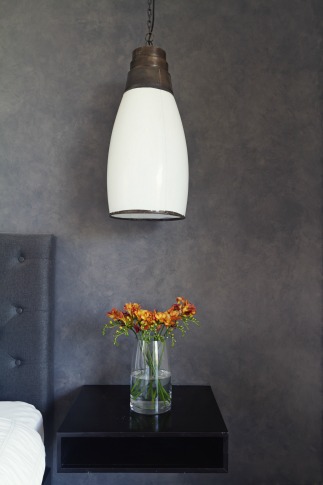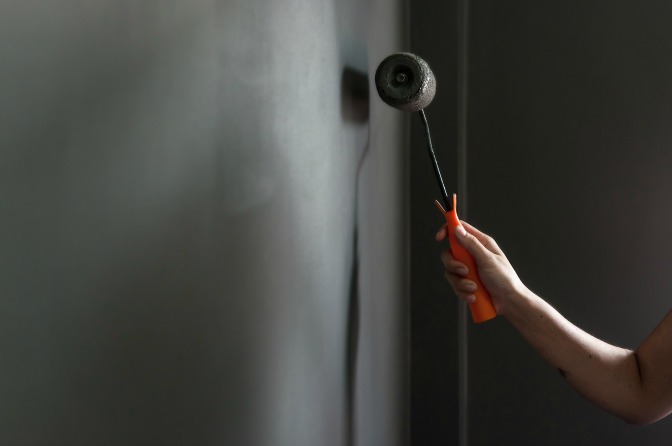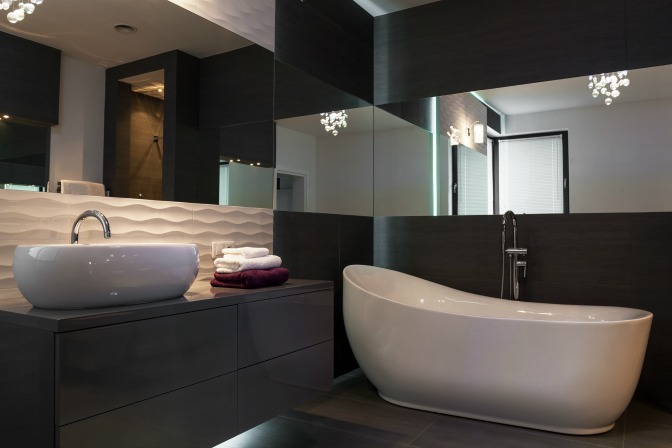Dark paint is an evocative way of bringing drama to a lacklustre space. However, light paint is consistently trumpeted as the best solution to a lack of natural light. Not only is this incorrect, it’s boring!
According to conventional design wisdom, a light paint color will reflect light in a room, making it seem brighter and larger. But this isn’t always the case. Expert interior designers know that no amount of white paint will make a space with insufficient lighting any brighter. This catch-all design advice is just too general for every space.
The thing is that many clients do prefer lighter wall colors. But if you, as an interior designer, can demonstrate your enthusiasm for working with darker colors, you may just able to transform mainstream design trends—one room and client at a time! Get inspired by reading our list of ways you can introduce your client to the school of dark interiors….
 Best-selling author and top interior designer Abigail Ahern argues that determining the specific atmosphere of a room is the pivotal first step to working with dark paint. Known for her dark interiors, she suggests choosing a mood, and then picking paint and accessories to create your vision—as opposed to trying to force random décor together based on an outdated color scheme.
Thinking in terms of ambiance means devoting some time to how your client wants to feel in a space. Consider a room’s purpose and go from there. Are you redoing a study? Does your client want something contemporary? Vintage first edition books aren’t the only way of bringing in sophistication. Think about a moody cobalt or a deep mulberry. Depending on your shade, you can warm up a space with a natural stone fireplace, or cool-toned textiles.
Best-selling author and top interior designer Abigail Ahern argues that determining the specific atmosphere of a room is the pivotal first step to working with dark paint. Known for her dark interiors, she suggests choosing a mood, and then picking paint and accessories to create your vision—as opposed to trying to force random décor together based on an outdated color scheme.
Thinking in terms of ambiance means devoting some time to how your client wants to feel in a space. Consider a room’s purpose and go from there. Are you redoing a study? Does your client want something contemporary? Vintage first edition books aren’t the only way of bringing in sophistication. Think about a moody cobalt or a deep mulberry. Depending on your shade, you can warm up a space with a natural stone fireplace, or cool-toned textiles.
 A deep, more complex paint will combat shadows in a darker room. Just make sure a cool-toned color is accompanied by flattering lighting—another way of bringing in warmth beyond paint color.
A deep, more complex paint will combat shadows in a darker room. Just make sure a cool-toned color is accompanied by flattering lighting—another way of bringing in warmth beyond paint color.
 Who would think that ceiling could be sexy? For an ultra-dramatic look, consider a dark color for this often overlooked surface. Many clients think ceiling is off-limits during a redesign. But shock them once again!
If a room is small, painting the ceiling a dark color will blur its boundaries, elongating the vertical line of a room. In a more expansive space, painting the ceiling a few shades lighter than wall color will create some visual interest and break up the room.
For a particularly daring look, limit dark paint to a ceiling. Can you imagine sleek hardwood with an unexpected rich color to draw the eye upwards?
Who would think that ceiling could be sexy? For an ultra-dramatic look, consider a dark color for this often overlooked surface. Many clients think ceiling is off-limits during a redesign. But shock them once again!
If a room is small, painting the ceiling a dark color will blur its boundaries, elongating the vertical line of a room. In a more expansive space, painting the ceiling a few shades lighter than wall color will create some visual interest and break up the room.
For a particularly daring look, limit dark paint to a ceiling. Can you imagine sleek hardwood with an unexpected rich color to draw the eye upwards?
 You can also balance a dark wall with trim that contrasts or complements. Showcase strong architectural elements in a room by using a bold white paint. Or continue to blur edges with a uniform color. A sumptuous window treatment can tie it all together.
You can also balance a dark wall with trim that contrasts or complements. Showcase strong architectural elements in a room by using a bold white paint. Or continue to blur edges with a uniform color. A sumptuous window treatment can tie it all together.
Pick your ambiance
A home is a blank slate. Design schemes don’t have to be limited by convention. If beige doesn’t seem to do it for your clients, it’s time to take them for a walk on the wild (and dark!) side. Best-selling author and top interior designer Abigail Ahern argues that determining the specific atmosphere of a room is the pivotal first step to working with dark paint. Known for her dark interiors, she suggests choosing a mood, and then picking paint and accessories to create your vision—as opposed to trying to force random décor together based on an outdated color scheme.
Thinking in terms of ambiance means devoting some time to how your client wants to feel in a space. Consider a room’s purpose and go from there. Are you redoing a study? Does your client want something contemporary? Vintage first edition books aren’t the only way of bringing in sophistication. Think about a moody cobalt or a deep mulberry. Depending on your shade, you can warm up a space with a natural stone fireplace, or cool-toned textiles.
Best-selling author and top interior designer Abigail Ahern argues that determining the specific atmosphere of a room is the pivotal first step to working with dark paint. Known for her dark interiors, she suggests choosing a mood, and then picking paint and accessories to create your vision—as opposed to trying to force random décor together based on an outdated color scheme.
Thinking in terms of ambiance means devoting some time to how your client wants to feel in a space. Consider a room’s purpose and go from there. Are you redoing a study? Does your client want something contemporary? Vintage first edition books aren’t the only way of bringing in sophistication. Think about a moody cobalt or a deep mulberry. Depending on your shade, you can warm up a space with a natural stone fireplace, or cool-toned textiles.
Use a good quality paint
For a small space without abundant natural light, a light paint can just look flat. And bland. Darker shades will blur the edges in a room, causing corners to recede. A good quality paint will have depth to allow for greater dimension. Paying more for a premium paint will ensure that you have more pigment than water. A cheaper paint will have a lower volume of solid materials, like pigment and binder, and more water, which will require more than one coat. Another benefit of going with a dark paint? It will cover flaws and imperfections. So if a wall is a looking a little shabby, a deep shade will help return it to its former glory.Play with lighting

Will you rock your client’s world by telling them a room that doesn’t receive much natural light is still in the running for dark paint? Just like a warm glow will cozy up a dreary day, lighting is another essential step to choosing the right paint for your space. Keep in mind that the way a wall reflects light will change according to time of day.
- North-Facing Room: Often a colder space—work with, not against, its cooler undertones.
- South-Facing Room: Generally full of by natural light. Warm or cool tones will look great.
- East-Facing Room: This room will receive the most light during the morning, until it reflects bluer tones later on in the day.
- West-Facing Room: Starker during the morning, this space will be flooded by afternoon light.
- Fluorescent: These bulbs emit a warmer light.
- Incandescent: A brighter, cooler light.
Edgy clients? Paint ceilings
 Who would think that ceiling could be sexy? For an ultra-dramatic look, consider a dark color for this often overlooked surface. Many clients think ceiling is off-limits during a redesign. But shock them once again!
If a room is small, painting the ceiling a dark color will blur its boundaries, elongating the vertical line of a room. In a more expansive space, painting the ceiling a few shades lighter than wall color will create some visual interest and break up the room.
For a particularly daring look, limit dark paint to a ceiling. Can you imagine sleek hardwood with an unexpected rich color to draw the eye upwards?
Who would think that ceiling could be sexy? For an ultra-dramatic look, consider a dark color for this often overlooked surface. Many clients think ceiling is off-limits during a redesign. But shock them once again!
If a room is small, painting the ceiling a dark color will blur its boundaries, elongating the vertical line of a room. In a more expansive space, painting the ceiling a few shades lighter than wall color will create some visual interest and break up the room.
For a particularly daring look, limit dark paint to a ceiling. Can you imagine sleek hardwood with an unexpected rich color to draw the eye upwards?
Think in terms of detailing
A dark paint will open up other possibilities in terms of how you accessorize with color. For example, a cool-toned heather grey will look stylish with other pops of color in décor. A dark paint may be just the way to offset the more juvenile colors that often go hand in hand with nurseries. Think of incorporating textiles in saturated tones, as well as different textures and prints. Eye-catching accessories will do the talking without looking like a rainbow. You can also balance a dark wall with trim that contrasts or complements. Showcase strong architectural elements in a room by using a bold white paint. Or continue to blur edges with a uniform color. A sumptuous window treatment can tie it all together.
You can also balance a dark wall with trim that contrasts or complements. Showcase strong architectural elements in a room by using a bold white paint. Or continue to blur edges with a uniform color. A sumptuous window treatment can tie it all together.

This article only addresses incandescent and fluorescent lights. New LED lights change everything with colour. Lighting is whiter in general these days. Can you address that, please?
Hi Barbara,
Thanks for your comment and suggestion! New LED lights do change everything! Definitely something we’re discussing in a future blog post. Stay tuned!